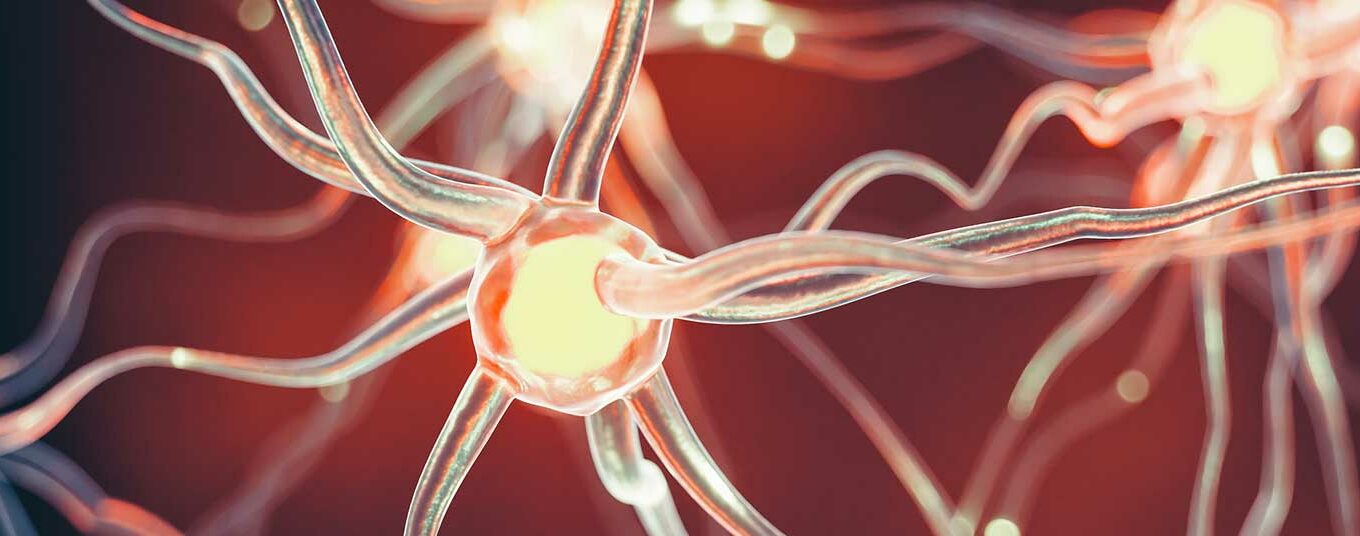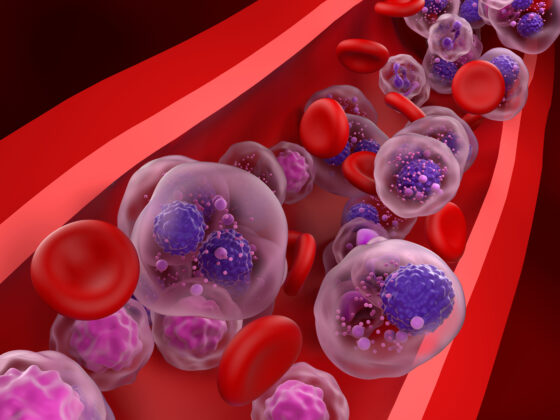The AAN Annual Meeting is one of the world’s largest gatherings of neurologists. The focus of the exchange is on the latest findings from science and research as well as clinical updates. The aim of the AAN conference is to promote high-quality, patient-centered neurological care and to improve the professional satisfaction of its members.
Up to 80% of all patients with multiple sclerosis (MS) suffer from pain and sensory symptoms, with the prevalence of neuropathic pain being around 26%. In the past, pain in MS was usually attributed to central lesions. Recently, several studies have been conducted investigating demyelinating large fiber peripheral neuropathies in MS patients. However, little research has investigated whether small, non-myelinated fibers are also affected with neuropathic pain and autonomic symptoms. Therefore, a study characterized small fiber neuropathy (SFN) in people with multiple sclerosis (pwMS) suffering from neuropathic pain and/or dysautonomia [1]. In a total of 28 patients, samples were taken from a proximal and distal site of the lower extremity and sent for evaluation of intraepidermal and sweat gland nerve fiber density. Symptoms and severity were characterized by recording responses to the MGH Small-Fiber Symptom Survey. Of 28 pwMS tested, 18 had significantly reduced intra-epidermal or sweat gland nerve fiber density in at least one of the biopsied sites. Two patients had low-normal values in at least one of the sampled sites, eight patients had normal nerve fiber densities. Of the patients who tested positive, 90% were female with an average disease duration of five years. The results of the MGH SSS showed total symptom severity scores ranging from 17 to 85. This small case series points to small fiber neuropathy as a possible cause of neuropathic pain and dysautonomia in people with disabilities.
Fatigue in pediatric MS patients
Although fatigue is frequently observed in pediatric Parkinson’s disease, little is known about the pathological causes in these patients. Therefore, an investigation of monoaminergic network abnormalities in pediatric multiple sclerosis (pedMS) patients in relation to their fatigue state was performed by positron emission tomography (PET)-based independent component analysis (ICA) on resting-state (RS) functional MRI (fMRI) [2]. Fifty-five right-handed pediatric MS patients and 23 matched healthy pediatric controls (HC) underwent neurological, fatigue, depression, and RS-fMRI assessment. Patients were categorized as fatigued (F) or non-fatigued (nF) based on their Fatigue Severity Scale (FSS ) score. The patterns of dopamine-, noradrenaline- and serotonin-related functional connectivity (FC) of RS were derived using ICA, which was restricted to PET atlases for dopamine, noradrenaline and serotonin transporters obtained in the brains of HCs.
None of the pedMS patients had depression, and fifteen of them were F. Compared to nF-pedMS patients and HC, F-pedMS patients showed reduced dopamine-related RS FC in the right postcentral gyrus. In addition, a reduced dopamine-related RS FC in the left insula was observed in F-pedMS patients compared to HC and an increased dopamine-related RS FC in the left middle temporal gyrus and cerebellar lobe VI compared to nF-pedMS. In the noradrenaline-bound network, F-pedMS patients showed decreased RS FC in the left superior parietal lobule and increased RS FC in the right thalamus compared to HC and nF-pedMS, and decreased RS FC in the right calcarine cortex and increased RS FC in the right middle frontal gyrus compared to HC. Finally, in the serotonin-related network, F-pedMS patients showed decreased RS FC in the right angular gyrus and increased RS FC in the right postcentral gyrus compared to nF-pedMS patients and HC. All in all, pediatric patients with fatigue showed specific abnormalities in monoaminergic networks, providing pathological markers for this troublesome symptom and potential targets for its treatment.
Reducing inflammation in MS and Alzheimer’s disease
MS and Alzheimer’s disease (AD) are at the center of interest in neuropathological research. MS is the neuroinflammatory disease par excellence, but inflammation is increasingly recognized as an independent driver of Alzheimer’s pathology, with microglial activation playing a key role. It might be expected that amyloids would be deposited in the MS brain, as the pathological features of amyloid plaques and neurofibrillary tangles that occur in Alzheimer’s disease are also found to a lesser extent in the normal, ageing brain. Furthermore, a coexistence of MS and Alzheimer’s pathology is likely, as there is anatomical overlap in the affected cortical areas. The chronic inflammatory environment of the MS cortex thus provides a unique model to further investigate the role of inflammation in amyloid physiology. Now the Aβ load in post-mortem samples of the temporal or frontal cortex in MS has been investigated and its relationship to motor cortical pathology assessed [3].
An autopsy cohort of pathologically confirmed MS cases (n=78) and control cases (n=67) was used in which Aβ load was correlated with neuron and microglia/macrophage density. Quantitative and semi-quantitative analyses were performed and correlated with the pathological characteristics. Decreased Aβ load was found in the normal-looking gray matter of MS cases who died under the median age (64 years) compared to matched controls, with a further reduction noted in MS-specific subpial demyelinated lesions. An increase in CD68+ microglia/macrophage expression and neuronal survival related to the reduction of Aβ was found in MS cases who died below the median age. These results suggest that MS-related factors, including microglia/macrophage inflammation, influence Aβ deposition and neurodegeneration, thus revealing new therapeutic perspectives relevant to both MS and Alzheimer’s disease.
Parkinson’s in patients with autoimmune diseases
The incidence of Parkinson’s disease is higher in autoimmune patients, which calls for further investigation into the influence of exposure to anti-inflammatory drugs. An investigation was therefore carried out into the relationship between the occurrence of Parkinson’s disease and the use of anti-inflammatory drugs, in particular anti-tumor necrosis factor (anti-TNF) and anti-interleukin (IL)-17, in people diagnosed with an autoimmune disease (rheumatoid arthritis, ulcerative colitis, Crohn’s disease, ankylosing spondylitis or psoriatic arthritis) [4]. In a retrospective cohort study, data from the US Komodo Health database was used to identify people diagnosed with autoimmune diseases between 2015 and 2022. To assess the comparative risk of Parkinson’s disease associated with anti-TNF/anti-IL-17 treatment, two cohorts of patients were distinguished: those exposed to a specific anti-inflammatory therapy and those not exposed. For the association analysis, the incidence rates of Parkinson’s disease per person were calculated and incidence rate ratios (IRRs) were derived. Person-time incidence rates per 100 person-years (PY) were calculated using quintiles of anti-TNF/anti-IL-17 exposure.
Of 2,105,677 autoimmune patients, 114,082 received anti-TNF/anti-IL-17 treatment, while 1,991,595 remained untreated. The PD incidence was 0.661 per 100 years in the exposed cohort compared to 0.949 per 100 years in the unexposed cohort. The IRR when comparing the exposed group with the non-exposed group was 0.696. The PD incidence rates for anti-inflammatory drug recipients were: anti-TNF only -0.665 and anti-IL-17 only -0.519. The IRR between anti-IL-17 and anti-TNF therapy showed that patients treated with anti-IL-17 had a lower risk of developing Parkinson’s disease. Analysis of incidence rates per person revealed a potential relationship between treatment and response, with an incidence rate of 5.295 in the lowest exposure quintile and 0.158 per 100 years in the highest exposure quintile. The results suggest that anti-TNF/anti-IL-17 treatment reduces the incidence of Parkinson’s disease in patients with autoimmune disease, suggesting that curbing systemic inflammation could potentially reduce the risk of developing Parkinson’s disease.
Predictors of ALS progression
ALS is a fatal neurodegenerative disease of the motor system that leads to death from progressive neuromuscular respiratory failure in most patients. The value of forced vital capacity (FVC) at clinical presentation and its rate of decline in predicting survival in ALS has now been examined in more detail [5]. The retrospective study included 153 patients who were cared for at the ALS clinic between 2016 and 2019 and for whom complete data sets were available. The initial FVC and its 3-month change were used for survival analysis using the Kaplan-Meier method and Cox regression model. Two main groups of patients were defined based on their initial FVC (“high FVC” if > median, “low FVC” if < median) and subgroups based on their FVC rate: (I) “initial high FVC/rapid decline”, (II) “initially high FVC/slow decline”, (III) “initial low FVC/rapid decline” and (IV) “initial low FVC/slow decline”. These subgroups were compared in terms of demographic, disease-related and survival characteristics.
An initial FVC above the median (>85%) was associated with a survival time of 39 months, while an FVC below the median was associated with a survival time of 16 months. The rate of FVC decline was also significantly associated with survival: Patients with a 3-month FVC slope ≥ the median value had a median survival of 41 months, while patients with a 3-month FVC slope below the median value had a survival of 16 months. A subgroup analysis showed that patients with “initial low FVC/rapid decline” had a median survival time of 13 months, while it was 26 months for patients with “initial low FVC/slow decline” and 47 months for patients with “initial high FVC/slow decline”. The results of the study suggest that the initial FVC and its decrease after three months are a reliable predictor of survival.
Immunological signature of late-onset myasthenia gravis
Myasthenia gravis (MG) is a heterogeneous autoimmune disease with autoantibodies against postsynaptic antigens at the neuromuscular junction. About 80% of MG patients have autoantibodies against AChR, and their clinical features and response to treatment may vary depending on clinical characteristics.
An investigation should determine whether there is a clear signature based on the presence of symptoms [6]. To this end, an exploratory in-depth proteomic analysis was performed to investigate the differences in the immunopathogenesis of acetylcholine receptor (AChR)-autoantibody-positive patients with early-onset (symptom onset <50 years) and late-onset myasthenia gravis (EOMG and LOMG) using the well-characterized BeatMG study.
Of the 52 patients from the BeatMG study with all required data points, the baseline samples of 47 patients were included. Twenty patients were classified as EOMG and 27 fell into the LOMG category. The EOMG group had a higher percentage of thymoidectomy patients (55% vs. 0%).
Principal component analysis showed a separation between the EOMG and LOMG groups and several proteins were highly expressed in the LOMG group, including CXCL17, JCHAIN, CD83 and TNFRSF11A. These proteins are involved in the regulation of leukocyte differentiation, interleukin-10 production and the differentiation and migration pathways of myeloid leukocytes. The TNFRSF11A SNP has previously been associated with LOMG. This could indicate that LOMG is possibly mediated by a different immunopathogenic mechanism.
Congress: American Academy of Neurology Annual Meeting (AAN)
Literature:
- Reyes K, et al: Characteristics of Small Fiber Neuropathy in a Cohort of Multiple Sclerosis Patients with Neuropathic Pain and/or Autonomic Dysfunction. Abstract S7.010. American Academy of Neurology Annual Meeting (AAN). 13-18.04.2024. Denver (USA).
- Margoni M, et al: Monoaminergic Network Abnormalities Explain Fatigue in Pediatric Multiple Sclerosis. Abstract S8.008. American Academy of Neurology Annual Meeting (AAN). 13-18.04.2024. Denver (USA).
- Pansieri J, et al: Reduced Aβ Amyloid Deposits Relate to Inflammation and Neuronal Survival in Multiple Sclerosis Cortex. Abstract S17.003. American Academy of Neurology Annual Meeting (AAN). 13-18.04.2024. Denver (USA).
- Haas J, et al: Association of Anti-inflammatory Therapy Use with the Incidence of Parkinson’s Disease: A Person-Time Analysis Among Patients with Autoimmune Diseases. Abstract S2.003. American Academy of Neurology Annual Meeting (AAN). 13-18.04.2024. Denver (USA).
- Seyam M, et al: Value of FVC and its Rate of Decline for Predicting Survival in ALS. Abstract S5.005. American Academy of Neurology Annual Meeting (AAN). 13-18.04.2024. Denver (USA).
- Roy B, et al: Proteomic Analysis Reveals a Distinct Immunological Signature for Late-onset Myasthenia Gravis. Abstract S15.003. American Academy of Neurology Annual Meeting (AAN). 13-18.04.2024. Denver (USA).
InFo NEUROLOGY & PSYCHIATRY 2024; 22(3): 20-21 (published on 30.5.24, ahead of print)











